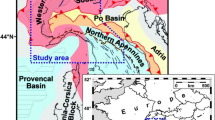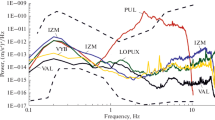Abstract
The territory of Lithuania and adjacent areas of the East European Craton have always been considered a region of low seismicity. Two recent earthquakes with magnitudes of more than 5 in the Kaliningrad District (Russian Federation) on 21 September 2004 motivated re-evaluation of the seismic hazard in Lithuania and adjacent territories. A new opportunity to study seismicity in the region is provided by the PASSEQ (Pasive Seismic Experiment) project that aimed to study the lithosphere–asthenosphere structure around the Trans-European Suture Zone. Twenty-six seismic stations of the PASSEQ temporary seismic array were installed in the territory of Lithuania. The stations recorded a number of local and regional seismic events originating from Lithuania and adjacent areas. This data can be used to answer the question of whether there exist seismically active tectonic zones in Lithuania that could be potentially hazardous for critical industrial facilities. Therefore, the aim of this paper is to find any natural tectonic seismic events in Lithuania and to obtain more general view of seismicity in the region. In order to do this, we make a manual review of the continuous data recorded by the PASSEQ seismic stations in Lithuania. From the good quality data, we select and relocate 45 local seismic events using the well-known LocSAT and VELEST location algortithms. In order to discriminate between possible natural events, underwater explosions and on-shore blasts, we analyse spatial distribution of epicenters and temporal distribution of origin times and perform both visual analysis of waveforms and spectral analysis of recordings. We show that the relocated seismic events can be grouped into five clusters (groups) according to their epicenter coordinates and origin and that several seismic events might be of tectonic origin. We also show that several events from the off-shore region in the Baltic Sea (at the coasts of the Kaliningrad District of the Russian Federation) are non-volcanic tremors, although the origin of these tremor-type events is not clear.















Similar content being viewed by others
References
Ankundinov, C., Brio, H., Sadov, A. (1987), Deep structure of the Earth’s crust in the territory of the Baltic countries on the basis of DSS studies. Belorussian seismological Bulletin. Minsk: 110–117. (In Russian).
Ankundinov, C., Sadov, A., Brio, H. (1994), Crustal structure of Baltic countries on the basis of deep seismic sounding data. Proc. Estonian Acad. Sci. V 43:129–136 (In Russian).
Baumgardt, D. R., and Young, G. B. (1990), Regional seismic waveform discriminants and case-based event identification using regional arrays. Bull Seism Soc Am, 88, 581–595.
Baumgardt, D. R., and Der, Z. (1998), Identification of Presumed Shallow Underwater Chemical Explosions Using Land-Based Regional Arrays. Bull Seism Soc Am, 80, 1874–1892.
Boborykin, A. M., Garetsky, R. G., Emelianov, A. P., Sildvee, H. H., Suveizdis, P. I. (1993), Earthquakes of Belarus and Baltic region. Current state of seismological observations and their generalization. In: Methodological Proceedings of Unified System of Seismological Observations N 4. Academy of Sciences Belarus, pp. 29–39.
Bratt, S. R., and Bache, T. C. (1988), Locating Events with a Sparse Network of Regional Arrays. Bulletin of the Seismological Society of America 78, 780–798.
Dangel, S., Schaepman, M. E., Stoll, E. P., Carniel, R., Barzandji, O., Rode, E. D., and Singer, J. M. (2003), Phenomenology of tremor-like signals observed over hydrocarbon reservoirs. Journal of Volcanology and Geothermal Research, V. 128, p. 135–158
Glitterman, Y., and van Eck, T. (1993), Spectra of quarry blasts and microearthquakes recorded at local distances in Israel. Bull Seism Soc Am, 83, 6, 1799–1812.
Glitterman, Y., and Shapira, A. (1994), Spectral characteristics of seismic events off the coast of the Levant. Geoph J Int, 116, 2, 485–497.
Glitterman, Y., and Shapira, A. (1998), Spectral classification methods in monitoring small local events by the Israel seismic network, Journal of seismology, 2, 237–256.
Glitterman, Y., Ben-Avraham, Z., Ginzburg, A. (1998), Spectral analysis of underwater explosions. Geoph J Int, 134, 460–472.
Gregersen, S., Voss, P. and TOR working group (2002), Summary of project TOR: delineation of a stepwise, sharp, deep lithosphere transition across Germany–Denmark–Sweden. Tectonics, 360, 61–73.
Janik, T., Kozlovskaya, E., and Yliniemi, J. (2007), Crust-mantle boundary in the central Fennoscandian shield: constraints from wide-angle P- and S-wave velocity models and new results of reflection profiling in Finland. J. Geophys. Res. 112, B04302. doi:10.1029/2006JB004681
Kennett, B. L. N., and E. R. Engdahl (1991). Traveltimes for global earthquake location and phase identification. Geophysical Journal International 122, 429–465.
Kissling, E. (1988), Geotomography with Local Earthquake Data, Rev. of Geophysics. 26, 659–698
Kissling, E., Ellsworth, W. L., Eberhart-Phillips, D., Kradolfer, U. (1994), Initial Reference Models in Local Earthquake Ttomography, J. Geophys. Res., 99, 19, 635–646.
Kissling, E., Kradolfer, U., Maurer, H. (1995), Program VELEST User’s Guide—Short Introduction, Institute of Geophysics, ETH Zuerich, Second draft version.
Kovachev, S. A. (2008), Results of Seismological Observations in the Western Kaliningrad Region and the Baltic Sea Water Area, Physics of the Solid Earth, 44, 9, 706–716.
Kozlovskaya, E., Karatayev, G., Yliniemi, J. (2001), Lithosphere structure along the northern part of EUROBRIDGE in Lithuania; results from integrated interpretation of DSS and gravity data. Tectonophysics, 339, 177–191
Menke, W. (1989), Geophysical data analysis: discrete inverse theory. Academic Press, New York, pp 289
Motuza, G. (2004), Žemės plutos bei kristalinio pamato sandaros ir sudėties raida. In: Baltrūnas, V. (ed.), Lietuvos žemės gelmių raida ir ištekliai, UAB Petro ofsetas, Vilnius, pp 11–40.
Motuza, G. (2005), Structure and formation of the crystalline crust in Lithuania. Polskie Towarzystwo Mineralogiczne–Prace specjalne Mineralogical Society of Poland–Special Papers, vol. 26, 69–79.
Nadeau, R. M. and Dolenc, D., (2005), Nonvolcanic Tremors Deep Beneath the San Andreas Fault, Science, 307, 389.
Pačėsa, A., Šliaupa, S., Satkūnas, J. (2005), Naujausi žemės drebėjimai Baltijos regione ir Lietuvos seisminis monitoringas, Geologija, 50, 8–18.
Raffaele, R., Fourno, J. P., Gresta, S. (2004), Minimum 1D Velocity Model from Local Earthquake Data in the Provence Region, South-Eastern France, Stud. Geophys. Geod., 48, 731–740.
Yliniemi, J., Tiira, T., Luosto, U., Komminaho, K., Motuza, G., Nasedkin, V., Jacyna, J., Šečkus, R., Grad, M., Czuba, W., Janik, T., Guterch, A., Lund, C.-E., Doody, J. J., EUROBRIDGE’95 seismic working group (2001), EUROBRIDGE’95: Deep Seismic Profiling within the East European Craton, Tectonophysics, 339, 1–2, 153–175.
Walter, W. R., Mayeda, K., and Patton, H. J. (1995), Phase and spectral ratio discrimination between NTS earthquakes and explosions Part 1: Empirical observations. Seism. Soc. Am., 85
Wessel, P. and Smith, W. H. F. (1995), New version of generic mapping tools released, Eos Trans, AGU, 76, 329
Wilde-Piórko, M., Geissler, W.H., Plomerová, J., Grad, M., Babuška, V., Brückl, E., Čyžienė, J., Czuba, W., Eengland, R., Gaczyński, E., Gazdova, R., Gregersen, S., Guterch, A., Hanka, W., Hegedűs, E., Heuer, B., Jedlička, P., Lazauskienė, J., Randy Keller, G., Kind, R., Klinge, K., Kolinsky, P., Komminaho, K., Kozlovskaya, E., Krűger, F., Larsen, T., Majdański, M., Málek, J., Motuza, G., Novotný, O., Pietrasiak, R., Plenefish, Th., Rŭžek, B., Šliaupa, S., Środa, P., Świeczak, M., Tiira, T., Voss, P., Wiejacz, P. (2008), PASSEQ 2006–2008: PASsive Seismic Experiment in Trans-European Suture Zone, Stud. Geophys. Geod., 52, 439–448.
Acknowledgments
Our study is a part of the PASSEQ 2006–2008 project, which was carried out by 17 organizations from 11 countries: University of Warsaw, Warsaw, Poland; Alfred Wegener Institute for Polar and Marine Research, Bremerhaven, Germany; Institute of Geophysics, Acad. Sci. Czech Rep., Praha, Czech Republic; Vienna University of Technology, Vienna, Austria; Geological Survey of Lithuania, Vilnius, Lithuania; Institute of Geophysics, Polish Academy of Sciences, Warsaw, Poland; University of Leicester, Leicester, Great Britain; Geological Survey of Denmark and Greenland, Copenhagen, Denmark; GeoForschungsZentrum Potsdam, Potsdam, Germany; Eötvös Loránd Geophysical Institute, Budapest, Hungary; University of Oklahoma, Norman, USA; Seismological Central Observatory, Erlangen, Germany; Institute of Rock Structure and Mechanics, Acad. Sci. Czech Rep., Praha, Czech Republic; University of Helsinki, Helsinki, Finland; University of Oulu, Oulu, Finland; University of Potsdam, Potsdam, Germany; University of Vilnius, Vilnius, Lithuania. The review of seismograms and locations of seismic events were performed during visit of I. Janutyte to the Sodankylä Geophysical Observatory of the University of Oulu in the framework of Erasmus program. Pre-processing of data of PASSEQ seismic stations in Lithuania was performed by Riitta Hurskainen and Mantas Budraitis at the Sodankylä Geophysical Observatory of the University of Oulu. The maps of locations were generated using Generic Mapping Tools (GMT) (Wessel and Smith 1995). We appreciate valuable comments of two anonymous reviewers that helped us to improve the previous version of the manuscript.
Author information
Authors and Affiliations
Consortia
Corresponding author
Additional information
List of the PASSEQ Working Group is given in "Appendix".
PASSEQ Working Group
PASSEQ Working Group
Monika WildePiorko(I), Wolfram H. Geissler(II), Jaroslava Plomerova(III), Marek Grad(I), Vladislav Babuška(III), Ewald Bruckl(IV), Jolanta Cyziene(V), Wojciech Czuba(VI), Richard England(VII), Edward Gaczyński(VI), Renata Gazdova(XIII), Soren Gregersen(VIII), Aleksander Guterch(VI), Winfried Hanka(VII), Endre Hegedűs(X), Barbara Heuer(IX), Petr Jedlička(III), Jurga Lazauskiene(V,XVII), G. Randy Keller(XI), Rainer Kind(IX), Klaus Klinge(XII), Petr Kolinsky(XIII), Kari Komminaho(XIV), Elena Kozlovskaya(XV), Frank Kruger(XVI), Tine Larsen(VIII), Mariusz Majdański(VI), Jiři Malek(XIII), Gediminas Motuza(XVII), Oldřich Novotny(XIII), Robert Pietrasiak(VI), Thomas Plenefisch(XII), Bohuslav Růžek(III), Saulius Sliaupa(V), Piotr Środa(VI), Marzena Świeczak(VI), Timo Tiira(XIV), Peter Voss(VIII), Paweł Wiejacz(VI)
(I) University of Warsaw, Warsaw, Poland
(II) Alfred Wegener Institute for Polar and Marine Research, Bremerhaven, Germany
(III) Institute of Geophysics Czech Academy of Sciences, Prague, Czech Republic
(IV) Vienna University of Technology, Vienna, Austria
(V) Geological Survey of Lithuania, Vilnius, Lithuania
(VI) Institute of Geophysics Polish Academy of Sciences, Warsaw, Poland
(VII) University of Leicester, Leicester, Great Britain
(VIII) Geological Survey of Denmark and Greenland, Copenhagen, Denmark
(IX) GeoForschungsZentrum Potsdam, Potsdam, Germany
(X) Eötvös Loránd Geophysical Institute, Budapest, Hungary
(XI) University of Oklahoma, Norman, USA
(XII) Seismological Central Observatory, Erlangen, Germany
(XIII) Institute of Rock Structure and Mechanics Czech Academy of Sciences, Prague, Czech Republic
(XIV) University of Helsinki, Helsinki, Finland
(XV) University of Oulu, Oulu, Finland
(XVI) University of Potsdam, Potsdam, Germany
(XVII) University of Vilnius, Vilnius, Lithuania
Rights and permissions
About this article
Cite this article
Janutyte, I., Kozlovskaya, E., Motuza, G. et al. Study of Local Seismic Events in Lithuania and Adjacent Areas Using Data from the PASSEQ Experiment. Pure Appl. Geophys. 170, 797–814 (2013). https://doi.org/10.1007/s00024-012-0458-8
Received:
Revised:
Accepted:
Published:
Issue Date:
DOI: https://doi.org/10.1007/s00024-012-0458-8




